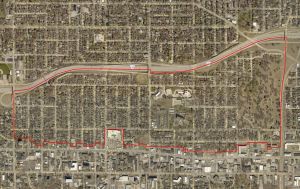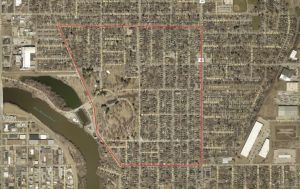
Homeowner Renovation Program
How do I start the process?
To begin the process, please fill out the Initial Interest Form on our website. A member of our staff will be in touch within one week to discuss your projects and start the process with you.
Do I need to cover some of the project costs?
Yes, all participating homeowners must pay for a portion of the renovations.
The Invest DSM grant covers between 20% and 50% of your costs, based on your project and neighborhood location.
You’ll pay for materials and contractors up front, then be reimbursed by Invest DSM for the agreed-upon grant amount after work is complete.
You can break the project into multiple milestones, if needed, and receive up to three draw payments from Invest DSM throughout the project.
Does Invest DSM have a list of preferred contractors I should work with?
No, Invest DSM does not have a list. However, we recommend getting 2-3 bids per project to ensure that you are getting a fair bid. We are happy to provide some suggestions if you would like.
Can I complete some of the work myself?
We do allow you to complete some work yourself, as long as you can demonstrate that you have the skills or license(s) required and you get any applicable building permits.
However, our preference is that the work is completed by a skilled contractor. We are happy to talk through the feasibility of projects you hope to do yourself.
Are projects I have already completed eligible for the grant?
No. Work completed in the past is ineligible for reimbursement. Similarly, any work completed before you sign the grant agreement is ineligible.
How quickly can I begin my project?
The answer depends on a few factors. Typically, the longest part of the process is getting bids for the projects.
After you receive bids from contractors and share them with Invest DSM, we’re usually able to get a grant agreement in place within 1-2 weeks. The grant agreement is the official green light for work to begin.
How long do I have after a grant agreement is signed to complete my projects?
We allow homeowners 10 months to get their projects completed.
How is the grant funding amount determined?
Our grant funding contribution is a percentage based on the total cost of your projects. We have three funding tiers: modest, moderate, and substantial.
Does Invest DSM make payments to my contractor?
No. Invest DSM makes payments to the homeowner after they’ve has paid the contractor(s).
What is the grant period?
The term “grant period” refers to the forgiveness period of your grant. If your projects fall within our second or third tier, there is a five- or seven-year forgiveness period.
You will receive the grant money up front as your projects are completed. The grant is then forgiven on a monthly, prorated basis throughout the five- or seven-year forgiveness period.
If you sell your house within the forgiveness period, you will be required to return a prorated amount of the grant to Invest DSM.
I don’t have any exterior projects planned, just interior ones. Does that make me ineligible?
- Not necessarily. If you are currently participating in our Block Challenge Grant program, that project can count towards the exterior component.
- In some cases, there may not be any exterior work needed, and Invest DSM could waive the requirement.
Is there anything that Invest DSM will not contribute toward?
The following items are ineligible, and costs will not be funded in any portion by Invest DSM:
- Front porch removal without replacement
- Open decks on the front of the house
- Chain link fences or a front-yard fence (some exceptions apply)
- Window coverings, furniture items, etc.
Costs for the following items may be included in any project. but Invest DSM may deem them ineligible if they collectively make up the majority of the total project costs.
- Stand-alone interior painting projects
- Stand-alone appliance purchases, no washers and dryers (Appliances must stay with the home.
Are there any requirements for materials that are used on my projects?
Invest DSM has a list of minimum material requirements. They can be found in Design & Construction Standards.
Can I participate in the program more than once?
Yes, you can participate in the program again, but there is a per property maximum grant amount based on your Special Investment District.
The only additional requirement is that all the projects listed in the previous grant agreement are completed before a new grant agreement is signed.
Invest DSM
What are the Special Investment Districts, and how were they chosen?
Invest DSM provides funding to strengthen specific Des Moines neighborhoods, called Special Investment Districts (SIDs): Columbus Park, Drake, Franklin Area, and Oak Park / Highland Park.
These SIDs were chosen after a months-long process of qualitative and quantitative research by the City of Des Moines and Polk County. Each of the selected neighborhoods has a distinctive history, community culture, and housing character that we aim to preserve and enhance for current and future generations of Des Moines residents.
Invest DSM’s strategy is based on national best practices. By focusing our funding and attention on targeted SIDs — rather than spreading our influence too thinly — we are more likely to spur significant change over a limited period of time. By working in a spectrum of middle-market neighborhoods, Invest DSM is testing and refining strategies that can then be expanded into different areas of the city with a wide array housing types and property values.
What qualities and amenities does Invest DSM nurture in the chosen neighborhoods?
- Access to parks, schools, and transportation
- Thriving business districts
- Social connection between neighbors
- A sense of community and belonging
- Walkability
- Safety and security
- Trust in the city and the local school system
- Reasonable energy costs
- Trees, flowers, and green spaces
- A demographically balanced neighborhood with diversity in race, income, age, and family type
Why does a strategy focusing on middle-market neighborhoods make the most sense?
Based on national best practices, the City of Des Moines and Polk County selected a few middle-market neighborhoods as the pilot areas for a long-term strategy aimed at improving quality of life, health, and safety for Des Moines residents.
Research shows that investing in middle-market neighborhoods has two major advantages: Limited financial resources go further and make a larger impact in middle-market neighborhoods than in those that are severely distressed. Such areas require different investment and implementation strategies, and many other government programs and nonprofit organizations are successfully serving these neighborhoods.
Secondly, immediate investment will prevent middle-market neighborhoods from sliding into a period of neglect and disinvestment, which other areas are unfortunately already struggling with. As we’ve seen in the public health arena, preventing injury is cheaper and more beneficial than treating an injury after it occurs. By using investment dollars efficiently in middle-market neighborhoods, more funding can go to those areas that require increased attention.
As Invest DSM’s efforts in the SIDs come to fruition over the next few years, the results will serve as evidence to support an expanded investment strategy throughout the city’s residential areas.
Why are diverse, mixed-income neighborhoods the goal?
As residents in these thriving neighborhoods have seen — and as social science research has shown — racially diverse, mixed-income neighborhoods are stronger than those where residents are all alike. Race and income diversity promotes a wide array of options for housing, business, and school type, as well as more varied land use.
Diverse, mixed-income neighborhoods have proven to be more resilient and quicker to come back after a crisis. The individual outcomes — both educational and financial — for residents are also improved in diverse neighborhoods.
Not only can diverse neighborhoods help to break the cycle of poverty that is a legacy of segregation, but residents of all races build more empathy, tolerance, and cross-cultural connection — contributing to a more socially and economically vibrant community.
What evidence can prove that Invest DSM’s strategy is successful?
Invest DSM staff use many complex metrics to guide strategy and evaluate outcomes. To put it more simply, though, Invest DSM is looking for — and already finding — these signs of success:
- Home values increasing
- New businesses opening
- Current residents staying put longer
- New residents moving in
- Rents staying affordable
- More housing types becoming available
How are neighborhood residents involved with Invest DSM on a grassroots level?
Invest DSM staff regularly attend neighborhood association meetings and stay in frequent contact with residents. Exit surveys — and the more involved but important work of personal conversations — provide feedback that is continually incorporated into process improvements for each of our programs.
How much funding does Invest DSM provide to private developers?
The vast majority of Invest DSM grants go to homeowners living in our Special Investment Districts.
Invest DSM does occasionally provide funding to developers looking to rehab single-family houses or construct homes on vacant lots. These projects are chosen carefully based on our goals for the neighborhood, including providing a diversity of housing options and keeping current residents in the neighborhood.
When developers do receive a grant, they put significantly more of their own money into the project than they get from Invest DSM. For example, as part of our Single Family Developer program, private investors have contributed nearly four times the amount that Invest DSM has invested. These projects occur in neighborhoods that often struggle to attract development without the incentives provided by Invest DSM.



